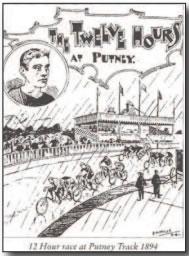


The concrete track, which opened in 1891 and it was built by James Barden*. The track was 4½ laps to the mile, square in shape, 20 feet wide and banked to 5 feet. The unusual track construction had a smooth concrete surface but the outer ‘belt' of the track was crossed by shallow corrugations to give a better grip for tyres and outside of that was well rolled gravel. There was also a cinder track of 5 laps to the mile, slightly banked, inside the concrete track. Putney was the home of the Putney Athletic Club, which had 100 members.
Herne Hill was dubbed ‘the fastest track in the world' in 1891, but this title was quickly usurped when the concrete track at Putney opened, just 3 months later. Putney did however have a reputation for being quite windy.
The Velodrome was initially called the Recreation Ground and it was formally opened with a meeting on August 1st 1891, organised by the Oakley Harriers. There were running races and the bicycle events were a half mile novices handicap and a one mile open handicap race. At that time it was common to note the type of tyre that competitors used. The vast majority of the riders at this meeting rode on pneumatic tyre, there were two ordinaries, one solid tyred safety and one rider with cushion tyres.
The first Putney Athletic Club meeting followed later in the year, on Thursday September 3rd 1891 and the bicycle events were a one mile carrier cycle race for locals, a 440 yards scratch race and a 880 yards handicap (all tyres). The opening event was marred by torrential rain.
The Surrey BC 50 miles championship race was held at Putney on August 6th 1892, with a small attendance. Selwyn Edge won off scratch in 2hr 4m 54s. There were lots of bicycle racing at Putney in the next couple years, including Charlie Barden's record attempts, ladies international races but most of the events were club or group meetings. Attendance at the larger events was low and press reports query the advertising effectiveness.
In March 1895, the name of the company owning the track was changed from Putney Athletic Club Grounds Ltd to Putney Velodrome Ltd, as an attempt to create more interest in the track. A six hour race was promoted in March 1895 and a 100 mile race a week later, but attendance was poor. There were company sports meetings every weekend and mid-week, including the Civil Service on May 25th, Lotus AC (Liberty & Co) on June 8th, News vendors sports July 27th and Artillery sport on July 13th. There was a 12 hour race on September 7th but the attendance was disappointing.
The Anerley BC held a paced 24 hour race for professional (unlicensed) riders on June 21st 1895 for the Carwardine Cup**. Four thousand spectators watched the race, which was won by CC Fontaine of the Polytechnic CC with 474 miles 1,568 yards. His ride just managed to beat Frank Shorland's previous amateur record distance.
There seemed to be not many professional races at Putney and 1896 saw the track well used for amateur club's athletic sports. In 1896, the Cawardine Cup raced moved to Herne Hill with a 100 mile race before going to Crystal Palace in 1897, where it stayed.
The Putney track seemed to be a well liked and friendly venue. Through the early 1900's the velodrome remained busy with amateur club and company sports meetings. Attendances varied from poor to good, there were 2,500 spectators at the Post Office sports in 1905. Track racing had however become less popular with the public and Putney velodrome was located in a desirable housing area. It was not surprising that, when the lease for the track came up for renewal, a developer took possession and new houses were built.
Commuter rail services to Putney had been expanded, which created a boom in house building and even though the velodrome was successful, it closed, and the last bicycle races at Putney were at the Abingdon CC's meeting on September 23rd 1905. The land was developed for housing by George Gale, to designs by Herbert Bignold, Architect, and the resulting houses, in an Arts and Crafts, English Vernacular style, were released for sale in 1908 and marketed, appropriately, as the Putney Velodrome Estate. The Estate comprised just two full streets (Landford and Earldom Roads) and a small part of a third (Hotham Road). This area of Putney remains the most distinctive part of the Landford Road conservation area.
* James Barden was the groundsman at Kensal Rise track and went on to design tracks at Putney, Northampton, Weston Super Mare and abroad in Denmark and Sweden. His son Charley Barden was an extremely successful international professional rider.
** The vice-president of the Anerley Bicycle Club was H Carwardine, who owned a large flour mill in London. In 1895, he donated the 5ft high silver Carwardine Cup (value 300 Guineas).

